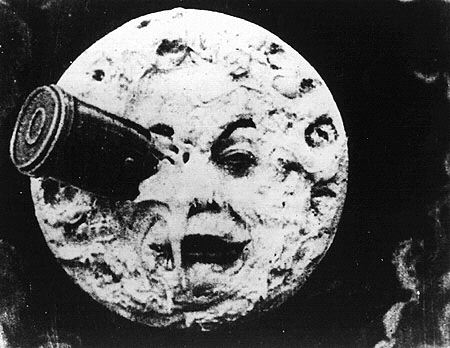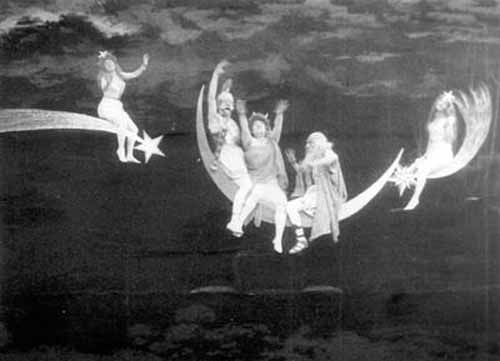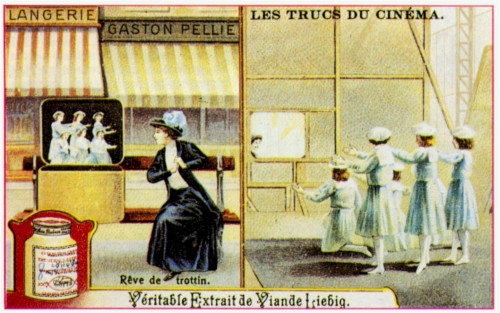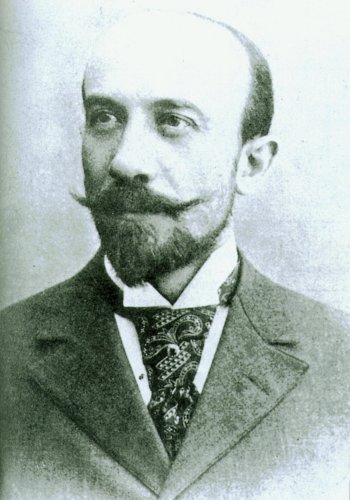
From
a strictly historical, generic perspective, the work of Georges Méliès
was a kind of magical dead end. Although his films are commonly
spoken of as the precursors of science fiction and all forms of film
fantasy involving special effects, they are in fact so peculiarly
original in form, so deeply rooted in the traditions of the stage, that
they presaged nothing.
Méliès
was a magician and the operator of a theater dedicated to stage
magic. He used cinema as an extension of the sort of acts he
performed and presented in his Théatre Robert-Houdin, built as a
showcase for his own art by Robert-Houdin, the great 19th-Century conjurer, the
legendary pioneer of modern theatrical magic (and the man after whom
his masterful successor Houdini named himself.)
Méliès
saw cinema as a way of presenting stage magic and amplifying its
effects by the use of in-camera tricks like stop motion and
super-imposition. His images evoked the stage precisely, with
strict proscenium framing and frankly theatrical painted flats and
props. He used many practical tricks from the stage, like flying
people and objects on wires or making them appear and disappear
through traps. He added his camera tricks on top of these
time-worn effects.

The problem was that camera trickery is not the same as live trickery
in the presence of the trickster — the novelty of camera tricks
dissipates quickly, once you become familiar with them. Méliès's
films were wildly popular for a while and then, with the rise of the
narrative form in movies, suddenly went out of fashion — to a degree
that live magic shows never have. In great live magic shows, you
know you're being tricked, but you can't for the life of you figure out
how. You may not know exactly how a camera trick works, but you
know it has to do with some fundamentally technical resource of the
medium — and so can't
be real magic. As early as 1905 people began to get wise to the
mechanical tricks of movies, as this postcard, part of a series, shows:

In movies, if the tricks are not done in the service of a story, or at
the very least in the service of creating a convincingly unified
alternate reality, they grow stale. Méliès
never tried to create a convincingly unified alternate reality — his
reality was always the reality of the stage, without the excitement of
the live presence of the performers. His magical stop-motion
substitutions were charming as ideas but could never take the breath
away like the “impossible” substitutions of the live magician.
Méliès
could not, in short, enlist the magic of the camera as an extension of
the magic of live stage performance. He created a vision of a
theater where anything was possible but in the process he lost the core
of the theatrical experience — the tangible presence of its spectacle.
Méliès influenced other filmmakers, like Edwin S. Porter, in the area of narrative. Méliès's
films occasionally have simple narrative structures, but these are
always just the armature for his tricks. He called his scenes
tableaux — they were self contained, and he was perfectly happy to
sell individual scenes as stand-alone attractions to the fairgrounds
showmen who constituted the initial market for his films. Each
scene had a gag, after all, and he saw the gags as the principal element of his
art.
When story films began to dominate the market he lost interest in the
industry, even as his audience lost interest in him. Storytelling wasn't at the heart of his ambition.

This is all speaking to the formal side of Méliès's work, but of course it had qualities which transcended its formal side. Méliès
had a sweet, antic, energetic, whimsical imagination which comes across
excitingly in his films, even today. It reminds one of the
imagination of the great Warner Brothers cartoonists of the 1940s,
silly, flip and surreal. But cartoon animation was of a piece and
so created an alternate universe that was of a piece, that audiences
could surrender to wholly. Méliès,
who never could leave the imaginative precincts of his beloved stage,
doesn't allow that kind of identification — we are always reminded
that we are, and are not, in a theater.
Méliès
was, in one sense, a great artist who made ephemeral art, in a form
that had no future. But his irresistible sensibility often soars
above the contradictions of his formal means. His films will
always be fun to watch, simply because it's so clear that he was having
an incredible amount of fun making them. He communicates his joy in stage magic and his
joy in camera magic, even if he never quite finds a way to reconcile
the two practices aesthetically.
In the history of cinema, his only legacy is joy — but there are many more important formal pioneers who left us less.
